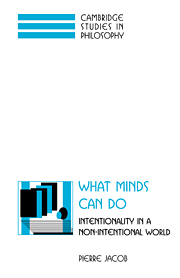Book contents
- Frontmatter
- Contents
- Acknowledgments
- Introduction
- PART I THE NATURALIZATION OF INTENTIONALITY
- PART II THE CAUSAL ROLE OF INTENTIONALITY
- 5 The computational representational theory of mind (CRTM)
- 6 Must an intentional realist be a meaning atomist?
- 7 Functionalism and the threat of preemption
- 8 Explaining intentional behavior
- 9 Conclusion: a postlude on semantics and psychology
- References
- Index
8 - Explaining intentional behavior
Published online by Cambridge University Press: 09 November 2009
- Frontmatter
- Contents
- Acknowledgments
- Introduction
- PART I THE NATURALIZATION OF INTENTIONALITY
- PART II THE CAUSAL ROLE OF INTENTIONALITY
- 5 The computational representational theory of mind (CRTM)
- 6 Must an intentional realist be a meaning atomist?
- 7 Functionalism and the threat of preemption
- 8 Explaining intentional behavior
- 9 Conclusion: a postlude on semantics and psychology
- References
- Index
Summary
CAMBRIDGE CHANGES AND NON-CAUSAL EXPLANATIONS
In the previous chapter, I have tried to defuse the threat of preemption. It is now time to meet the challenge of externalism. The threat of preemption arose from the fact that the semantic properties of an individual's propositional attitudes are higher-order physical properties, not basic physical properties, of his or her brain. The challenge of externalism arises from the fact that genuinely semantic properties of an individual's propositional attitudes are not local properties of his or her brain. If externalism is correct, then the semantic properties of a pair of beliefs simultaneously entertained by a pair of microphysical duplicates may differ from each other as a genuine $100 bill differs from a counterfeit or a genuine Picasso painting differs from a forgery. The authenticity of either a genuine $100 bill or a Picasso painting seems to be an extrinsic property of either a piece of paper or a canvas. In one case, the piece of paper bears a special historical relation to the authoritative governmental agency who impressed a stamp on it. In the other case, the canvas bears a special historical relation to Picasso's intentions and hands. But it seems, a genuine $100 bill and a counterfeit may have the same causal properties, just as a forgery may have the same causal properties as a genuine Picasso painting. They may reflect photons in the same way and react to chemical tests indistinguishably.
- Type
- Chapter
- Information
- What Minds Can DoIntentionality in a Non-Intentional World, pp. 234 - 269Publisher: Cambridge University PressPrint publication year: 1997



